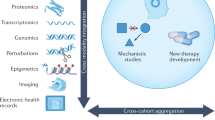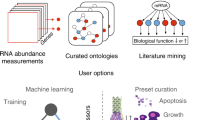Abstract
‘Biology and cancer research have developed together. Invariably, at each stage, the characteristics of the cancer cell have been ascribed to some defect in whatever branch of biology happens at the time to be fashionable and exciting; today, it is molecular genetics’. Tremendous transformations have occurred in cancer research since these few lines were written by John Cairns: the discovery of oncogenes and anti-oncogenes, and the successful development of ‘magic bullets’ targeting the proteins encoded by these oncogenes. Nevertheless, Cairns’ message is still valid. In 1978, he observed the first attempts to apply the tools and concepts of molecular biology to cancer; today, this research field reflects multiple and diverse efforts that go ‘beyond’ molecular biology by looking for explanations that have been left aside during its development, or by privileging new approaches, fully original or actively pursued in other fields of biological research. Because of this specific characteristic of cancer research, it is possible to use it as an indicator of trends in biological research in general.
This is a preview of subscription content, access via your institution
Access options
Subscribe to this journal
Receive 50 print issues and online access
$259.00 per year
only $5.18 per issue
Buy this article
- Purchase on Springer Link
- Instant access to full article PDF
Prices may be subject to local taxes which are calculated during checkout
Similar content being viewed by others
References
Bao S, Wu Q, McLendon RE, Hao Y, Shi Q, Hjelmeland AB et al. (2006). Glioma stem cells promote radioresistance by preferential activation of the DNA damage response. Nature 444: 756–760.
Bartkova J, Rezaei N, Liontos M, Karakaidos P, Kletsas D, Issaeva N et al. (2006). Oncogene-induced senescence is part of the tumorigenesis barrier imposed by DNA damage checkpoints. Nature 444: 633–642.
Bild AH, Yao G, Chang JT, Wang Q, Potti A, Chasse D et al. (2006). Oncogenic pathway signatures in human cancers as a guide to targeted therapies. Nature 439: 353–357.
Bissell MJ, Radisky D . (2001). Putting tumours in context. Nat Rev Cancer 1: 46–54.
Borczuk AC, Cappellini GCA, Kim HK, Hesdorffer M, Taub RN, Powell CA . (2007). Molecular profiling of malignant peritoneal mesothelioma identifies the ubiquitin-proteasome pathway as a therapeutic target in poor prognosis tumors. Oncogene 26: 610–617.
Cairns J . (1978). Cancer, Science, and Society. Freeman: San Francisco, p 63.
Downward J . (2006). Prelude to an anniversary for the RAS oncogene. Science 314: 43–44.
Feinberg AP, Tycko B . (2004). The history of cancer epigenetics. Nat Rev Cancer 4: 143–153.
Ferres-Marco D, Gutierrez-Garcia I, Vallejo DM, Bolivar J, Gutierrez-Avino FJ, Dominguez M . (2006). Epigenetic silencers and Notch collaborate to promote malignant tumours by Rb silencing. Nature 439: 430–436.
Frantz S . (2005). Playing dirty. Nature 437: 942–943.
Greenman C, Stephens P, Smith R, Dalgliesh GL, Hunter C, Bignell G et al. (2007). Patterns of somatic mutation in human cancer genomes. Nature 446: 153–158.
Hanahan D, Weinberg RA . (2000). The hallmarks of cancer. Cell 100: 57–70.
Hiratsuka S, Watanabe A, Aburatani H, Maru Y . (2006). Tumour-mediated upregulation of chemoattractants and recruitment of myeloid cells predetermines lung metastasis. Nat cell biol 8: 1369–1375.
Kamal A, Thao L, Sensintaffar J, Zhang L, Boehm MF, Fritz LC et al. (2003). A high-affinity conformation of Hsp90 confers tumour selectivity on Hsp90 inhibitors. Nature 425: 407–410.
Kaplan RN, Riba RD, Zacharoulis S, Bramley AH, Vincent L, Costa C et al. (2005). VEGFR1-positive haematopoietic bone marrow progenitors initiate the pre-metastatic niche. Nature 438: 820–827.
Kerbel RS . (2006). Antiangiogenic therapy: a universal chemosensitization strategy for cancer? Science 312: 1171–1175.
Kiberstis PA, Travis J . (2006). Celebrating a glass half-full. Science 312: 1157.
Kinzler KW, Vogelstein B . (1996). Lessons from hereditary colorectal cancer. Cell 87: 159–170.
Lund AH, van Lohuizen M . (2004). Epigenesis and cancer. Genes Dev 18: 2315–2335.
Manchester KL . (1995). Theodor Boveri and the origin of malignant tumours. Trends Cell Biol 5: 384–387.
Marx J . (2003). Mutant stem cells may seed cancer. Science 301: 1308–1310.
Marx J . (2006). Autophagy: is it cancer's friend or foe? Science 312: 1160–1161.
Morange M . (1997). From the regulatory vision of cancer to the oncogene paradigm, 1975–1985. J Hist Biol 30: 1–29.
Morange M . (2006). Twenty-five years ago: the production of mouse embryonic stem cells. J Biosci 31: 537–541.
O'Brien CA, Pollett A, Gallinger S, Dick JE . 2007. A human colon cancer cell capable of initiating tumour growth in immunodeficient mice. Nature 445: 106–110.
Odling-Smee FJ, Laland KN, Feldman MW . (2003). Niche Construction: The Neglected Process in Evolution. Princeton University Press: Princeton.
Pelham RJ, Rodgers L, Hall I, Lucito R, Nguyen KCQ, Navin N et al. (2006). Identification of alterations in DNA copy number in host stromal cells during tumor progression. Proc Natl Acad Sci USA 103: 19848–19853.
Piccirillo SGM, Reynolds BA, Zanetti N, Lamorte G, Binda E, Broggi G et al. (2006). Bone morphogenetic proteins inhibit the tumorigenic potential of human brain tumour-initiating cells. Nature 444: 761–765.
Ramanathan A, Wang C, Schreiber SL . (2005). Perturbational profiling of a cell-line model of tumorigenesis by using metabolic measurements. Proc Natl Acad Sci USA 102: 5992–5997.
Ricci-Vitiani L, Lombardi DG, Pilozzi E, Biffoni M, Todaro M, Peschle C et al. 2007. Identification and expansion of human colon-cancer-initiating cells. Nature 445: 111–115.
Soto AM, Sonnenschein C . (2004). The somatic mutation theory of cancer: growing problems with the paradigm? BioEssays 26: 1097–1107.
Triolo VA . (1965). Nineteenth century foundations of cancer research: advances in tumor pathology, nomenclature, and theories of oncogenesis. Cancer Res 25: 75–106.
Valk-Lingbeek ME, Bruggeman SWM, van Lohuizen M . (2004). Stem cells and cancer: the polycomb connection. Cell 118: 409–418.
Waddington CH . (1941). Canalization of development and the inheritance of acquired characteristics. Nature 150: 563–565.
Warburg O . (1956). On the origin of cancer cells. Science 123: 309–314.
Weaver BA, Cleveland DW . (2006). Does aneuploidy cause cancer? Curr Opin Cell Biol 18: 658–667.
Weinberg RA . (1982). Fewer and fewer oncogenes. Cell 30: 3–4.
Author information
Authors and Affiliations
Corresponding author
Rights and permissions
About this article
Cite this article
Morange, M. The field of cancer research: an indicator of present transformations in biology. Oncogene 26, 7607–7610 (2007). https://doi.org/10.1038/sj.onc.1210583
Received:
Revised:
Accepted:
Published:
Issue Date:
DOI: https://doi.org/10.1038/sj.onc.1210583
Keywords
This article is cited by
-
Mapping the continuum of research strategies
Synthese (2019)
-
A Possible Role for Philosophy: Bridging the Conceptual Divide in Cancer Research
Acta Biotheoretica (2018)
-
Protein-based identification of quantitative trait loci associated with malignant transformation in two HER2+ cellular models of breast cancer
Proteome Science (2012)



